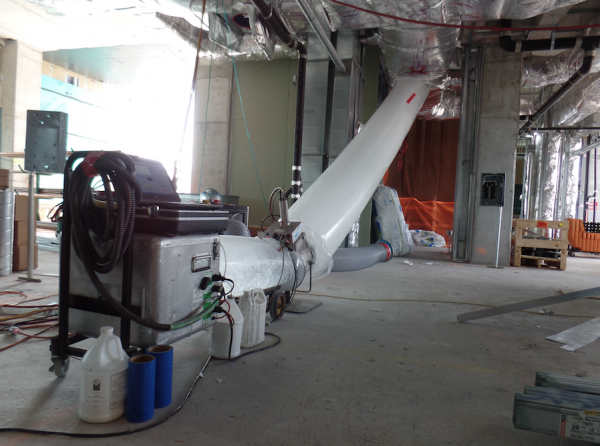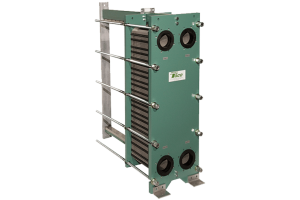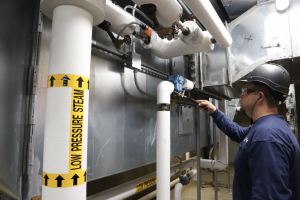
Castrads, the leading manufacturer of premium cast iron radiators, has announced the opening of a new 8,000 sq ft warehouse facility on Robins Lane in Syosset, Long Islan...

Cornell Tech Passive House Turns to Duct Sealing Innovation to Make Super Energy-Efficient HVAC System Work
World’s Largest Passive House Building Requires Tons Of Ductwork, Low Airflow, And Tight Duct System Achievable Only With Aeroseal Duct Sealing Technology
Aeroseal LLC today announced that the company’s breakthrough duct sealing technology proved critical to the successful design and implementation of the ultra-high-efficiency HVAC system used in the new 26-story Cornell Tech Passive House residential tower. Completed earlier this summer, The House at Cornell Tech is the world’s largest building to meet Passive House criteria, the strictest international standards for building performance and energy efficiency.
At the heart of the building’s unique Passive House design is an HVAC system designed to provide exceptional comfort and indoor air quality for a fraction of the residents’ usual energy costs. The engineer’s responsible for the design of the mechanical system specified the use of aeroseal technology from the start.
“To achieve Passive House standards, it’s important to have an extremely tight building envelope, and that requires an energy efficient way to bring fresh air to all the living spaces while exhausting air from kitchens and bathrooms,” said Julie Janiski, project manager at BuroHappold Engineering, the Structure/MEP/Lighting Design engineers on the project. “All that required a lot of ductwork delivering air at very low CFM (cubic feet of air per minute). This meant that the ducts had to be tighter than traditional manual sealing typically provides, in order to ensure that those low CFM targets were fully delivered to the living spaces.”
To ensure the duct tightness necessary for proper system functioning, the sealing experts at Taitem Engineering were brought in to seal the entire duct system using aeroseal duct sealing technology.
Unlike traditional duct sealing, aeroseal works from the inside of the ducts to seal leaks. The sealing equipment is connected to the ductwork via a long flexible tube and sealant is blown into the duct interior, where it automatically locates and seals the leaks.
“We divided and sealed the ductwork one section at a time,” said Evan Hallas, operations manager, Taitem Engineering. “The computerized Aeroseal system measures results as the sealant is being applied, so we knew the results were impressive before we were even done.”
It took Taitem Engineering’s three-man crew just eight days to tightly seal the building’s complete duct system, including more than 55 vertical risers running the height of the building, plus hundreds of horizontal runners branching from the risers to each individual room, kitchen and bathroom in the 350-unit apartment building.
The final testing showed that the aeroseal technology reduced leakage by an average of 98% with final leakage rates under 1% - well within engineering specifications.
“It seems a bit like magic when you watch the aerosealing process,” said Ryan Lobello of Handel Architects, the architectural firm on the project. “The report generated by the sealing system gives an equivalent hole size for the amount of remaining leakage, and it was so small we couldn’t even really draw a representation of it.”
“There was skepticism from those who were concerned that such a large duct system running at such a low flow rate could ever get the required amount of CFM from the rooftop fans down to the bottom floors,” said Hallas. “But they are now believers, and aeroseal is the key that made it work.”
For more information on Aeroseal or its use on the Cornell Tech Passive House, visit www.aeroseal.com or call (937) 428-9300.

To ensure the ductwork met the virtually leak-free requirements of the building’s high efficiency HVAC system design, engineers sealed the ducts using a breakthrough duct sealing technology that works from the inside to find and seal all the leaks.

Castrads, the leading manufacturer of premium cast iron radiators, has announced the opening of a new 8,000 sq ft warehouse facility on Robins Lane in Syosset, Long Islan...

Taco is committed to delivering innovative solutions that help our customers achieve the highest levels of efficiency and reliability. That’s why they developed PF Series...

American Plant Maintenance (APM Steam), a leading provider of steam systems maintenance services, highlights its steam trap survey services, which can be used to create a...